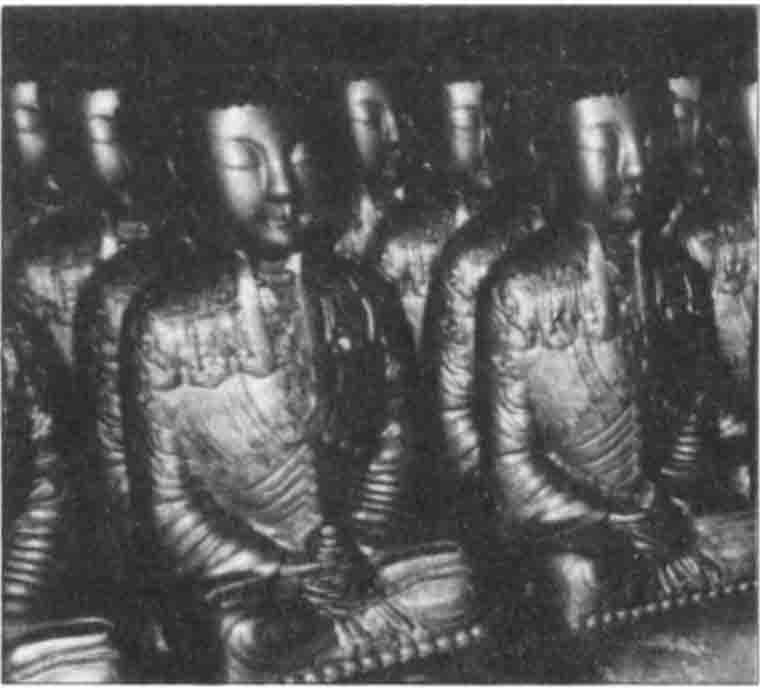 |
丹霞禪師為何燒佛取暖?
Why did Dhyana Master Danxia burn a Buddha image for warmth? |
丹霞禪師燒佛取暖的舉動,曾令不少後人推崇,以為眼中無聖賢、無父母、無師長、無規矩,就是道法自然,這真是令人悲哀的狂妄自大。
丹霞下跪時,他拜的是佛,是自性;燒像時,他用的是木,是火性。說心無分別,其實仍有分別;只是以慧心圓融了俗理、教理而已。哪怕他燒遍所有寺廟的佛像,也不能改變這樣一個事實:釋迦牟尼佛總歸是他的導師。
以此為喻,倘若我燒了禪宗以此故事為榮的威信,也是為了自己的應用。禪宗依然是禪宗,佛依然是佛,我也依然是俗人。倘若一個俗人的像被燒會怎樣呢?充其量他的家人會與你拼命而已。而丹霞燒木佛的故事讓人講了幾百年,倘若沒有嚼頭,又何必一說再說呢?只有能發出光明的東西才有這個作用;否則你想燒出他的歷史價值都不可能。佛之偉大正在於此。哪怕進入涅槃之境,他的化身形像,依然可以暖人。
【編按】:唐天然禪師,以至性天然,不假修飾而得名;又因住錫丹霞山,而被尊稱為丹霞禪師。一日,禪師偶至洛陽慧林寺,夜晚天寒,便取殿中木刻佛像來燒火取暖,一眾驚駭呵責,禪師便說:「我是在燒取舍利子。」眾人說:「木頭怎能燒出舍利子?」禪師就說:「既然木佛燒不出舍利子,那就再取兩尊來燒吧!」。
佛教自漢末傳入中國,經六朝而大為流行。至唐朝不唯人才輩出,六祖而後,更是教派林立。當時奉經教一派的人,執著教相,不悟自心是佛,所以禪宗一派不立文字,以實際行動來破除世人的執著。這樁公案因之在禪門十分有名,讓後世一提再提,譽為無相無著之最高境界。但這種境界雖高,其行為卻只許像丹霞禪師這樣至性天然、圓融無礙的人偶一為之,不能也不容他人做效。當時世人執著「形式之有」固不知自心即佛;後學者盲目推崇仿效其皮毛,亦是執著「無礙之空」,流於口頭禪。終究都落在兩邊,都無法見自本性,也都還是有礙。
事實上,丹霞禪師此舉,若說是有意地在「破執」也不盡正確。考其為人,他應該是率性自然不假思索造作的一種行事,純然因應需要。所以天然禪師之為天然禪師,絕非浪得虛名。誠如姚居士文中所云:「他拜的是佛,是自性;燒像時他用的是木,是火性」「哪怕他燒遍所有寺廟的佛像,也不能改變這樣一個事實:釋迦牟尼佛終歸是他的導師。」甚至更可以說:即使燒遍木佛,也不能改變這樣一個事實:他是他自性的主人翁,他禮敬的是他自性的佛。
至於世俗的毀譽,於他無關,也於佛無關。「禪宗依然是禪宗,佛依然是佛。」 |
|
Dhyana Master Danxia’s burning of a Buddha image to get warmth won the admiration of people in later generations. Such people think that to do away with worthies and sages, fathers and mothers, teachers and superiors, as well as all rules is to follow the way of spontaneity, to accord with Nature. Such unmitigated arrogance is truly pitiful.
When Chan Master Danxia knelt and bowed, it was to the Buddha, the self nature. When he burned the image, what he burned was wood, using the nature of fire. In saying that the mind has no discriminations, actually, there are distinctions made; it's just that mundane principles and the principles contained in the Teaching become perfectly fused when one's wisdom opens. Even if he burned all the Buddha images in all the temples and monasteries, he still could not change the fact that Shakyamuni Buddha was his Guiding Master.
By the same principle, if I attempt to destroy the faith which the Chan school proudly places in this story, then that would merely be for my own personal satisfaction. The Chan school is still the Chan school; a Buddha is still a Buddha; and I am still a common person. What if an image of a common person were be burned? At most, the person's family members would fight with you. But the story of Chan Master Danxia burning the wooden Buddha has been discussed for several hundred years. If there were nothing in it, why would people bother to keep talking about it? Only brilliant events warrant such a reaction; and even if one might wish to erase it from history, it cannot be done.
The magnificence of the Buddha is also shown in this: Even after he entered Nirvana, people could still get warmth from a wooden likeness of him.
[Editor's Note] Dhyana Master Tianran (Natural) of Tang Dynasty got the name because his nature was natural and unpretentious. Moreover, because he lived on Mount Danxia, he was reverently addressed as Dhyana Master Danxia. One day, he happened to go to Huilin Monastery in Loyang. The night became freezing, and so he took a carved wooden Buddha and burned it to get warmth. Everyone was astonished and scolded him. The Dhyana Master said, "I'm burning it to get sharira." The assembly asked, "How can you get sharira from burning wood?" The Dhyana Master said, "Since wooden Buddhas don't possess sharira, go and get another couple of images to burn!"
Buddhism came into China at the end of Han Dynasty and became popular after the Six Dynasties period. Down to Tang Dynasty, not only were there many talented sages, but enormous schools developed after the time of the Sixth Patriarch. At that time, those who followed the Teaching School attached to the attributes of teaching and failed to realize the mind is the Buddha. Therefore, the Chan School did not rely on language, but used real actions to break through people's attachments. This public record became so renowned in the Chan School that people of later generations cited it over and over, praising it as the ultimate state of no attributes and no attachments. The state was high all right, but such an act could only be done by a person like Dhyana Master Danxia, who was completely natural and sincere, perfect and without obstructions. No one could possibly imitate that example. At that time, people attached to "the existence of form" and failed to realize that the mind is the Buddha; students of later generations blindly admired and superficially imitated his behavior, attaching to "emptiness of non-obstruction" and turning it into intellectualizing about Chan. They fell into the two extremes and failed to realize the self nature, and so they still had obstructions.
As a matter of fact, if one says that what Dhyana Master Danxia did was deliberately designed to break through attachments, that's not completely true. Based on what he was, his action was more likely straightforward and natural, free of any consideration or attention. He was just doing what was necessary in that circumstance. That's why he was called Dhyana Master Tianran (Natural). He didn't get that name for no reason. As it's said in Upasika Yao's essay, " When Chan Master Danxia knelt and bowed, it was to the Buddha, the self nature. When he burned the image, what he burned was wood, using the nature of fire. Even if he burned all the Buddha images in all the temples and monasteries, he still could not change the fact that Shakyamuni Buddha was his Guiding Master." We could even say, "Even if he burned all the wooden Buddhas, he still could not change the fact that he was the master of his self nature. He was worshipping the Buddha of his self nature."
As for slander and praise of those in the world, it has nothing to do with him or with the Buddha. "The Chan school is still the Chan school, a Buddha is still a Buddha." |